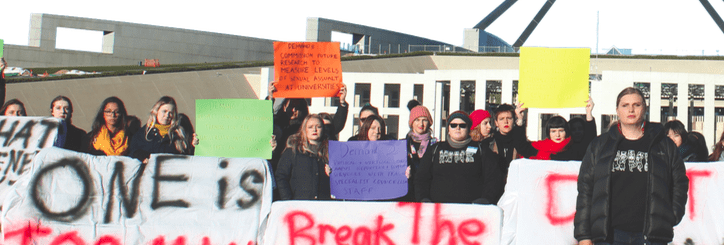When the Women’s Department was cleaning out the Women’s Space a few weeks ago, I found campaign materials protesting sexual violence which was 40 years old. I was so confronted because the problems they spoke about are the same ones we are facing today. It made me wonder: how this issue has been allowed to go on for so long?
My disbelief, of course, comes partly from a place of horror. My instinct to support and believe survivors is so strong that I can’t comprehend why universities don’t punish such a heinous crime. But, it is also shocking to me because students and activists have been fighting this issue for decades, and to little avail.
We have seen dozens of survivors go public with stories of mistreatment, Women’s Collectives and allies have been staging protests and campaigning since the 1970s, and, anecdotally, we know that most people will know someone who is a survivor of sexual assault. Yet, by most metrics, not a lot has changed in the way universities respond to sexual assault, and the problem is as rampant as ever.
If this story has raised any concerns, you can contact:
Canberra Rape Crisis Centre, Crisis Line
(02) 6247 2525
ANU Counselling
(02) 6125 2442
1800 RESPECT
1800 737 732
ANU Women’s Department
Contact the Women’s Officer, Holly Zhang:
– For non-urgent inquiries: sa.womens@anu.edu.au
– For urgent matters: 0467 092 808
It makes me wonder, how did this happen? How have universities defeated so many campaigns over so many years?
Step 1: Students alert the administration of the issue. In response, the administration ignores or minimises the issue. Students may alert the administration to ‘red flags’, they may present demands or reform proposals, and in response… nothing. Administrators may nod in agreement and give an understanding smile so that students get the impression they are on the same side. But then there is total inaction.
Step 2: Students escalate pressure through organising campaigns, petitions, protests, speaking to the media, etc. to try and force administrations to act. In the past year, we can see evidence of this; the Open Day and Wesley College protests at the University of Sydney, women coming forward about the ‘Eagle Rock’ rituals at B&G, the NOWSA mattress protest at Parliament House and numerous articles and disclosures published in student and mainstream media.
Step 3: Administrations offer to consult with students, and set up a committee to look into the issue. For most organisers, this is thought to be a win. If an administration is seen to be cooperating, it is often seen as counter-intuitive to continue escalation strategies. As a result, the campaign group often becomes demobilised and disintegrates. It is also much harder to maintain public pressure, especially through the media, when the university is seen to be cooperating.
Students begin working with the administration, usually volunteering their time and labour for free.
Step 4: Progress slows down. Delaying tactics are a particularly effective one for universities. The institutional memory in student organisations is limited.
Students are only at university for a very limited period of time – so it is only a matter of time before they go home for the summer or graduate. Most student leaders serve their organisation on a one-year term. The handover from one leader to the next is not always guaranteed, particularly when you factor in burn-out which means that leaders often step away from activism once their term is over.
The result is that the administration can let the committee die or ignore student contributions because the pressure on them to act has relaxed. Students working on the issue leave, and their replacements often struggle to learn the ropes and the momentum going. Nothing changes.
Repeat steps 1-4.
What this cycle illustrates is that universities have refused to take proactive action. They have swept the issue under the rug and, while they do nothing, more and more students’ safety is put at risk. All the while, the burden of supporting survivors of sexual assault and campaigning against sexual violence has fallen on students. Students have had to remind universities of their basic duty to provide a safe learning environment. Students have been first responders and the support person for survivors. Students have been left to envision, design and reform policies and procedures.
Ensuring students’ safety is the one of the most essential pillars of a productive living and educational environment. This is not student’s responsibility. Enough is enough. It’s the university’s turn to take a
stand against sexual violence.
In 40 years-time, when members of the Women’s Department look through our campaign materials, I hope they don’t have the same reaction I did.
Freya Willis is the Deputy Officer of the ANU Women’s Department
We acknowledge the Ngunnawal and Ngambri people, who are the Traditional Custodians of the land on which Woroni, Woroni Radio and Woroni TV are created, edited, published, printed and distributed. We pay our respects to Elders past and present. We acknowledge that the name Woroni was taken from the Wadi Wadi Nation without permission, and we are striving to do better for future reconciliation.
